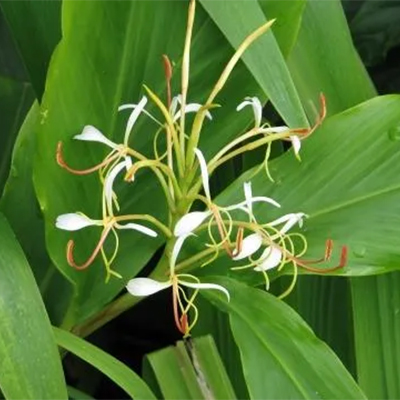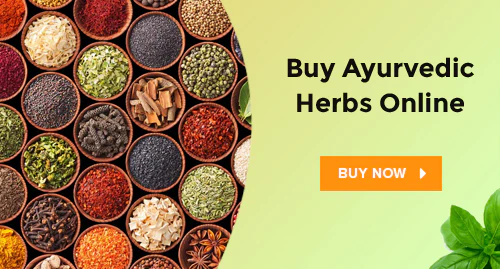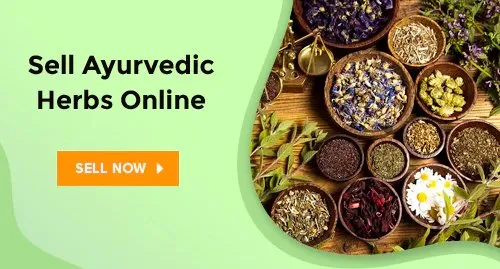On This Page
Shati: A Rhizome Full of Essential Oil
Introduction
Hedychium spicatum commonly known as Spiked ginger lily in English and Shati in Hindi is an important medicinal plant that belongs to the Zingiberaceae family. Locally, Shati is known as Ban Haldi or Kuchri and is well distributed in the entire Himalayan region. Shati plays a significant role in Ayurveda due to its extraordinary quality of curing diseases like fever, liver-related problems, respiratory disorders, joint pain, hair loss, vomiting, etc. Shati is a treasure house of essential oil which gives it therapeutic properties like antioxidant, anti-inflammatory, anti-microbial, anti-diabetic, hepatoprotective, appetizer, carminative, antihelminthic, etc. Shati’s rhizomes are used in very well-known formulations i.e Chyavanprasha and are also used to provide aroma to tobacco. Shati is well used in pharmaceutical, food, and aromatic industries due to various active ingredients like phenolics and flavonoid compound in it. It is also known as Ekangi, Kapoor Kachli, Spiked Ginger Lily, Kapur Kachri, Kachuralu, etc.
Basonym of Shati
शयति। शट रुजादौ।
Shati is having many nodes in rhizomes, and it is very useful in various painful ailments.
Synonyms of Shati
- According to habitat:
हिमो उद्भव – हिमवत्प्रदेशे जायमाना।
Shati commonly grows in a cold climate.
- According to morphology:
कर्चूर – कर्चति कर्च गतो।
Rhizomes of Shati spread in all directions.
षड्ग्रन्था – षट तद्विका वा ग्रन्थ्यो कंदे अस्याः।
Rhizomes will have a minimum of six nodes.
- According to properties and action:
गंधपलाशी – गन्धवन्ति पलाशानी पत्राण्यस्याः।
Leaves of Shati have a strong odor.
गंधमूलिका – गन्धवमूलस्या।
Rhizomes of Shati have got strong odor.
Regional Names of Shati
- Kapur Kachri (Hindi)
- Sheduri (Punjabi)
- Shimai-Kichchilik-Kishangu (Tamil)
- Gandhashati, Seeme Sunthi (Kannad)
- Spiked Ginger Lily (English)
- Kacholam (Malayalam)
- Kapurkachari (Marathi)
Botanical Name
Hedychium spicatum Buch – Ham
Hedychium – In Hedychium “Hedys means sweet”, “Chion means snow sweet-scented, flowers are fragrant”
Spicatum – Spicatum means spiked. Therefore, Shati is a plant with fragrant spiked flowers.
Family
Zingiberaceae
Ayurveda Reference for Shati (Hedychium spicatum)
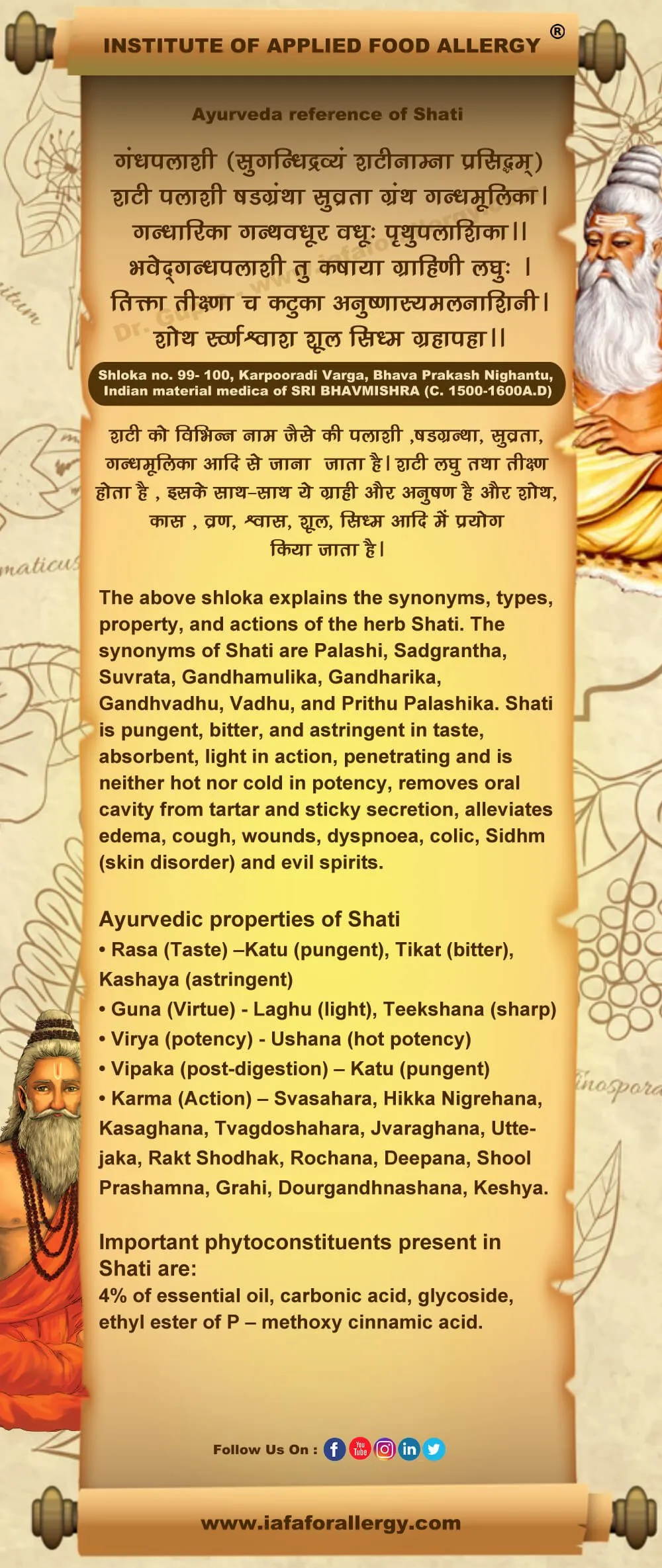
Scientific Classification of Shati
| Kingdom | Plantae |
| Class | Monocotyledons |
| Series | Epigyne |
| Family | Zingiberaceae |
| Genus | Hedychium |
| Species | Spicatum |
Classification of Shati as per Charaka and Sushruta
- Charaka: Swashara Mahakshaya, Hikkanigrehana Mahakshaya
- Sushruta: Shaakvarga
Shati Description in Brihtrayi
| Charaka | Shusruta | Vagbhata (Ashtang Hridya) |
| C. S. Su. 4/ 30, 37 | S. S. Su. 46/ 276 | A. H. Su. 6/ 72 |
| C. S. Su. 27/ 86 | S. S. Sa. 2/ 9 | A. H. Chi. 3/ 13, 14, 15, 20, 31, 37, 49, 56, 60, 95, 127, 160 |
| C. S. Chi. 1. 1/ 61 | S. S. Chi. 5/ 28 | A. H. Chi. 4/ 24, 28, 40, 44, 46, 53 |
| C. S. Chi. 3/ 210, 211, 212, 224, 266 | S. S. Chi. 12/ 5 | A. H. Chi. 5/ 16 |
| C. S. Chi. 5/ 69, 78, 85, 144 | S. S. Chi. 37/ 8, 17, 24, 37, 39 | A. H. Chi. 6/ 31, 33, 34, 52 |
| C. S. Chi. 6/ 40 | S. S. Chi. 38/ 26 | A. H. Chi. 8/ 46, 90 |
| C. S. Chi. 8/ 100, 107, 110 | S. S. U. 39/ 197, 221 | A. H. Chi. 9/ 12, 20, 26, 51 |
| C. S. Chi. 11/ 34 | S. S. U. 42/ 28 | A. H. Chi. 10/ 27, 61 |
| C. S. Chi. 12/ 58 | S. S. Chi. 51/ 40 | A. H. Chi. 12/ 19, 25 |
| C. S. Chi. 13/ 125 | S. S. Chi. 52/ 30, 41 | A. H. Chi. 14/ 10, 14, 31, 81 |
| C. S. Chi. 14/ 73, 92, 125, 132 | A. H. Chi. 15/ 14 | |
| C. S. Chi. 15/ 87, 108, 165, 168 | A. H. Chi. 17/ 20 | |
| C. S. Chi. 17/ 101, 103, 122, 128, 141 | A. H. Chi. 21/ 57, 75 | |
| C. S. Chi. 18/ 38, 48, 49, 50, 52, 56, 76, 91, 105, 113, 114, 117, 122, 158, 175 | A. H. Ka. 4/ 60, 63 | |
| C. S. Chi. 19/ 30, 35, 48 | A. H. Ka. 5/ 19 | |
| C. S. Chi. 26/ 59, 83, 84, 85, 96, 169 | A. H. U. 1/ 46 | |
| C. S. Chi. 28/ 121, 149, 167 | A. H. U. 2/ 25 | |
| C. S. Si. 4/ 9, 13, 20 | A. H. U. 24/ 53 | |
| C. S. Si. 7/ 17, 18 | A. H. U. 35/ 59 | |
| C. S. Si. 12/ 56 | A. H. U. 39/ 34 |
External Morphology of Hedychium Spicatum (Shati)
Habit: Herbaceous plant with an underground stem. Erect glabrous herb, 1 – 1.5 m high, with the perennial rhizome.
Leaves: Leaves are simple, with entire margins. More than 30 cm long. Oblong or oblong-lanceolate, variable in breadth. It is glabrous.
Inflorescence: Densely flowered spike, up to 30 cm long. Bracts are large, oblong, green, 25 to 4 cm long and 2 cm wide; 1flowered.
Flowers: White, cuneate lip, and deeply bifid.
Fruits: Capsule, glabrous and globose.
Flowering and fruiting time
Flowering and fruiting of Shati occur between July to October.
Controversy
Few researchers consider Curcuma cassia as Shati. Curcuma cassia is Kali Haldi and Shati is Hedychium spicatum and both are entirely different from each other.
Substitute
Hedychium coronarin is used as a substitute for Hedychium spicatum.
Distribution of Shati
Shati is a native plant of southeastern Asian countries. Globally, Shati is distributed in Nepal, Bhutan, India.
In India, Shati occurs in the parts of Western and Central Himalayas at altitudes of 3,500- 7,500 feet or generally 5,000- 7,000 feet. (2000 m.) in Western Himalayas and Kumaon. It is found in Himachal Pradesh and the hilly areas of Uttar Pradesh. Plants grow in Sikkim and other regions also.
The Useful Part of Shati
The useful part of Shati is the rhizome.
Important Phytoconstituent of Shati
The main active principle is Hedychenone, 7 – Hydroxyhedychenone.
Rhizome of Shati contains 4% of volatile oil and 52% of starch. The volatile oil contains para methoxy cinnamic acid, Cineole limonene, Ethyl cinnamate, Hedychenone, 7-hydroxybedychnone, Methy1paracumarin, Limonene, Beta Phellandrene, Bterpineol, and Cinnamic ethyl acetate.
Recent Research on Shati
- Antimicrobial
- Anti-inflammatory
- Hepatoprotective
- Antidiabetic
- Ameliorative efficacy
- Tranquilizing activity
- Pediculicidal
- Anti-helminthic
- Antipyretic
Rasa-Panchaka (Properties) of Shati
| Rasa (Taste) | Katu (Pungent), Tikat (Bitter), Kashaya (Astringent) |
| Guna (Virtue) | Laghu (Light), Tikshana (Sharp) |
| Virya (Potency) | Ushana (Hot Potency) |
| Vipaka (Post-Digestion) | Katu (Pungent) |
| Karma (Action) | Svasahara, Hikka Nigrehana, Kasaghana, Tvagdoshahara, Jvaraghana, Uttejaka, Rakt Shodhak, Rochana, Deepana, Shool Prashamna, Grahi, Dourgandhnashana, Keshya. |
Prayogarha Vyadhi (Therapeutic Indication) of Shati
Swasha, Kasa, Hikka, Shoth, Vrana, Shool, Sidhma
Aamyik Prayog (Therapeutic Uses) of Shati
- Atisara (Diarrhea): The diet should contain a soup of Shati.
(Ashtang Hridya. Chi. 9. 20-21)
- Arsha (Piles): The patient should be given gruel prepared with Shati leaves or Pippali or sunthi soured with buttermilk and added with Maricha powder.
(Charaka Samhita. Chi. 14/ 92)
- Tamaka Shwasa (Bronchial asthma):
- Powder of Shati and Puskaramula and Amalaka or simply Lauha Bhasma should be taken with honey.(Charaka Samhita. 17/ 129, also in Ashtanga Hridya Chi. 4/ 30, 40)
- Shatyadi Churna (Charaka Samhita Chi. 17/ 123- 34) contains Shati as the main drug.
- Amavata (Rheumatoid arthritis): Paste of Shati and Shunthi mixed with a decoction of Punarnava should be taken for a week. It alleviates Amavata.
(Vrinda Madhava 25/ 3, also in Bhava Prakasha Chikitsa. 26/ 42)
- Shukra Gata Vyadhi (Semen disorder): In the case of nodular semen, ghee cooked with Shati or ash of Palasha should be used.
(Sushruta Samhita Sa. 2/ 8)
Important Benefits of Shati
- Hair growth (Kesha Vardhana): Decoction of the rhizome of Shati is used to wash the hairs. This makes hair clean, soft, smooth, and thick.
- Rhinitis (Pratishaya): Shati when taken in combination with Bhumi- Amalaki and Trikatu (saunth, Marich, and Pipali) give excellent results in Rhinitis.
- Hepatic disorder (Yakrit Vikara): The decoction of the rhizome of Shati gives marvelous results in hepatic disorders due to its hepato-protective activity.
- Vomiting (Chardi): Shati rhizome powder mixed with rose water helps in relieving vomiting.
- Shati also has insect repellent properties.
Matra (Therapeutic Administration and Dosage) of Shati
- Powder (Churna) – 1 to 3 grams

Have A Health Issue?
Consult Online
- Dr. Sahil Gupta (B.A.M.S., M.H.A.)
Ayurvedic Allergy Specialist
CEO & Founder of IAFA®
Classical Reference of Shati (Hedychium spicatum)
Kaiyadeva Nighantu, Aushadhi Varga, 1391 – 1393
गन्धारिका गंधवधुर्वधु: पृथुपलाशिका।
शठी सुगन्धबाला स्यात् सोमदा सोमसम्भवा।।
सुगन्धमूला षडग्रन्था सुव्रता सुगृहीतिका।
शठी तिक्तकटुस्तीक्ष्णा कषाया ग्राहिणी लघुः।
अनुष्णा मुखवैरस्य मूलदौर्गंध्यनाशनी।
दोषकासव्रणश्वासशूलहिदमाज्वरापहा।।
Raja Nighnatu, Pippalyadi Varga, 226 – 231
शटी
शटी शठी पलाशश्च षडग्रंथा सुव्रता वधूः।
सुगन्धमूला गंधाली शटिका च पलाशिका।।
सुभद्रा च तृणी दूर्वा गन्धा पृथु पलाशिका।
सौम्या हिमो उद्भावा गन्ध वधुना गेंदुसम्मिता।
शटी गुणाः
शटी सतिक्ता अम्लरसा लघु उष्णा रूचिप्रदा च ज्वरहारिणी च।
कफास्रकण्डूव्रणदोषाहन्त्री वक्त्रामय ध्वंसकरी च सो उक्ता।।
शटी विशेष गुणाः
अन्या तु गन्धपत्रा स्यात् स्थूलास्या तिक्तकन्दका।
वनजा शटिका वन्या स्त वक्शीर्येकपत्रिका।।
गन्धपीता पलाशान्ता. गन्धाढ्या गन्धपत्रिका ।
दीर्घपत्रा गन्धन्निशा शरमूह्मा सुपाकिनी ॥
गन्धपत्रा कटुः स्वादु तीक्ष्णो कफवातजित्त।
कासच्छर्दिज्वरान् हन्ति पित्तकोपं करोति च॥
Sushruta Samhita, Sharira Sthana , 2/ 8
ग्रन्थिभूते शुक्रे
ग्रन्थि भूते शटी सिद्धं पालाशे वापि भस्मनि।
Ashtanga Hridya, Chikitsa Sthana, 9- 20/ 21
अतिसारे
शट्यामूलकपोतायाः पाठायाः स्वस्तिकस्या वा।
मूषायवानीकर्कारुरिणीचिर्भटस्य वा॥
उपोदिकाया….. लोणिकाया रसैरपि ॥
Ashtanga Hridya, Chikitsa Sthana, 4/ 39, 40
शटीपुष्करधात्रीवां पौष्करं वा कणान्विताम्।
गैरिकाज्जन कृष्णां वा स्वरसं वा कपित्थजम् ॥
रसेन वा कपित्थस्य धात्रीसैन्धवपिप्पली: ॥
Charaka Samhita Chikitsa Sthana , 14/ 92
अर्श
शटीपलाशसिद्धां वा पिप्पलया नागरेण वा।
दद्याद यवागुं तक्र अमलां मरीचैरवचूर्णितां।।
Charaka Samhita, Chikitsa Sthana, 17- 123/ 124
श्वास
शट्यादि चूर्णम।
Charaka Samhita, Chikitsa Sthana , 17 / 121
शटीपुष्करमूलानां चूर्णमामलकस्य च।
मधुना संयुक्त लेह्म चूर्ण वा काललोहजम्।।
Chakradutta Amavaata Chikitsa, 25 – 3
आमवाते शट्यादि क्वाथे
शटी शुण्ठ्याभया चोग्रा देवाह्मातिविषा अमृता ।
कषायामामवातस्य पाचनं रूक्षभोजनम् ॥
Chakradutta, Aamvaat Chikitsa, 24 – 4, Vrinda Madhava 25 – 3, Bhava Prakasha Chikitsa, 6 – 42
शटी विश्वौषधीकल्कं वर्षाभूक्वाथसंयुतम् ।
सप्तरात्रं पिबेजजन्तुरामवातविनाशनम् (विपाचनम्) ॥
Specific Formulation of Shati
- Shatyadi Kshaya indicated for Sannipataja Jvara
- Shatyadi Yoga indicated for Hikka, Swasha
- Shatyadi Churna indicated for Gulma, Plihavriddhi
- Chyavanaprasha indicated as Rasayana and for Kasa
- Amritaprasha Ghrita indicated for Swasha Roga and Jvara.
Some Other Important Formulations of Shati are as Follows:
- Haritkyadi Churna
- Usher Asava
- Chardihara Vati
- Arvinda Aasava
- Nityananda Rasa
- Sarivadyasava
Contraindication and Side Effects of Shati
Till now after the use of Shati in the advised dosage, no side effects have been reported. It is advised to avoid the usage of Shati during pregnancy and breastfeeding.
Suggestive Readings Regarding Shati
- Kaushik, Raman. (2014). Shatyadi Choorna – a critical review.
- Ghildiyal S, Gautam MK, Joshi VK, Goel RK. Pharmacological evaluation of extracts of Hedychium spicatum (Ham-ex-Smith) rhizome. Anc Sci Life. 2012;31(3):117-122. doi:10.4103/0257-7941.103189
- “Formulation And Evaluation Of Antiemetic H. spicatum Lozenges”, International Journal of Emerging Technologies and Innovative Research (www.jetir.org), ISSN:2349-5162, Vol.7, Issue 11, page no.771-776, November-2020, Available: http://www.jetir.org/papers/JETIR2011384.pdf
- Hedychium spicatum: a systematic review on traditional uses, phytochemistry, pharmacology and future prospectus.
- A REVIEW ON HEDICHIUM SPICATUM – SHATI by Herwade Ajitkumar Shantinath, Mandavkar Kalpana C.
- HEDYCHIUM SPICATUM BUCH-HAM. (KUCHRI), A TREASURE HOUSE OF ESSENTIAL OILS by ISHA KUMARI, HEMLATA KAURAV, GITIKA CHAUDHARY.
- Effect of Light vs. Dark on Seed Germination of Hedychium Spicatum Smith A.S. Bisht, Megha Sati Sonali Rana, R.S.Chauhan.
References
- Agnivesha, Charaka, Dridhabala . In: Charaka Samhita, ed. Vaidya Jadavaji Trikamji Aacharya., editor. Varanasi: Chaukhamba Sanskrit Sansthan; 2009.
- Sushruta. In: Sushruta Samhita, Sutra Sthana, ed. Vaidya Jadavji Trikamji Acharya., editor. Varanasi: Choukhambha Orientalia; 2005.
- Vagbhata. In: Ashtanga Hrudaya, 9th ed. Anna Moreshwar Kunte, Krishnashastri Navarre, Harishastri, editors. Varanasi: Choukhambha Orientalia; 2005.
- Bhavamishra. In: Bhava Prakasha Nighantu, 11th ed. part 2. Brahma Shankara Mishra., Karpooradi Varga, editor. Varanasi: Choukhambha Bharati Academy; 2009.
- Bhavprakasha, commentary by Bulusu Sitaram, forwarded by K.C.Chunekar
- Dhanvantari Nighantu, Diwedi BK. Editor. Guduchyadi varga, Chaukhamba Krishnadas Academy, Varanasi; 2008.
- Raja Nighantu, Pipalyadi Varga, editor, Varanasi.
- Sharma PV, Kaideva Nighantu. Aushadhi Varga. Chaukhamba Orientalia, Varanasi; 2006:
- Tripathi I., Raja Nighantu, pipalyadi varga, Chaukhamba Krishnadas Academy; Varanasi; 2010
- Dr. Gyanendra Pandey, Dravyaguna Vigyana, reprint 2012, Chowkhamba Krishnadas Academy
- K.niteshwar Dravyagunavigyana, reprint 2017.
- Dr. J.L.N. Sastry and Dr. B.S. Sastry, Dravyaguna Vigyana, Chaukhambha Orientalia, Varanasi.
- Chakrapanidatta, chakradatta with the vaidayaprabhahindi commentary by indradevatripathi, chaukambha sankritasansthan, varanai 2nd Edition, 1994.
Ayurveda is an Indian system of medicine that is popular since ancient times. Dr. Gupta’s IAFA® has been conducting research studies to find out different phytoconstituents of herbs and their action in the body. Such knowledge acquired by our experts is used in the preparation of medicines and providing the treatment facilities safely and effectively. IAFA® is the provider of safe and effective treatment for a wide range of diseases, mainly allergic diseases all based on Ayurveda.
Was this Page Helpful?
Read More Articles
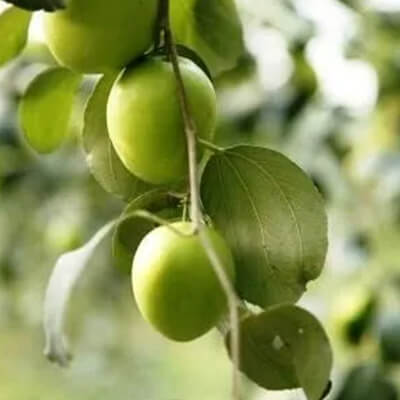
Souvira / Raja Badara (Zizyphus Sativa, Ziziphus Xylopyrus, Zizyphus Vulgaris) – Part – 2
Souvira or Raja Badara botanically known as Zizyphus vulgaris or Zizyphus xylopyra is a deciduous tree…
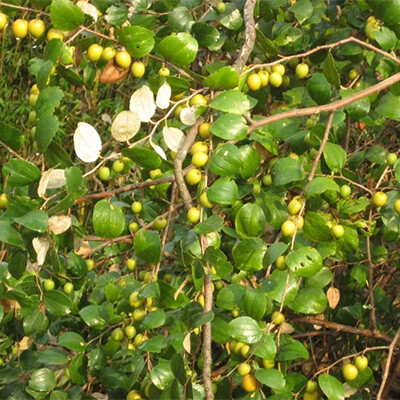
Karkandhu / Kshudra Badara (Zizyphus Nummularia) – Part – 3
Karkandhu or Z. nummularia is a type of Badara that is commonly…
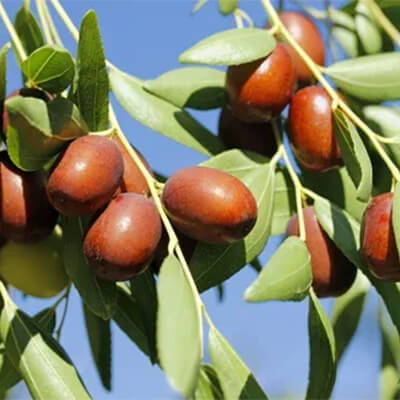
Badara / Kola (Ziziphus Jujuba, Ziziphus Mauritiana) – Part – 1
Badara is wildly and cultivated found in India and it is a…

